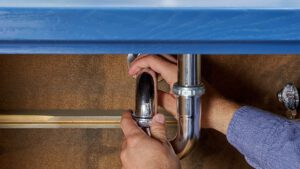Plumbing is the art of conveying fluids for a wide variety of applications. It uses pipes, valves, plumbing fixtures, tanks, and other apparatuses. Whether it’s water, waste water, or steam, plumbing is necessary for a wide variety of situations. Whether you’re installing a new toilet, installing a dishwasher, or replacing a faucet, plumbing is an essential part of every home.
There are many different materials used for water supply pipes in homes. Some of these materials are metallic, such as steel or galvanized steel. Others are plastic, such as PVC. The materials used in the water supply are generally characterized by their high resistance to corrosion and durability. Some of the most common types of water piping include PVC, copper, and cast iron.
In commercial buildings, water supply piping systems are often sized using one or more codes and standards adopted by various local authorities. Two major codes are the Uniform Plumbing Code (UPC) and the International Plumbing Code (IPC). The purpose of these codes and standards is to provide a general guideline for sizing water piping distribution systems.
Water supply systems typically consist of surface water pipes and groundwater pipes. Surface water is the most common source for public water systems, while groundwater supplies are used by smaller rural communities. A well-designed water distribution network ensures that water remains clean and sanitary all along the way to its final users. Some towns have large-diameter main pipes that supply an entire city, while others have smaller branch lines that serve a street or a group of buildings.
One way to size water supply pipes is by considering the number of fixtures that will be using the water. While toilets are the most common water supply fixtures in a building, other areas may also require a water supply. For example, kitchens may require make-up water, while other facilities may need water to operate equipment and washing systems. In these situations, you’ll need to calculate the flow requirements for each type of water supply pipe to properly size it for each location.
Drainage is the basic process of channeling waste liquids out of a building. It can direct waste to another area or discharge it into stormwater mains or sewers. A sink drain discharges water when no longer needed. Its main purpose is to remove wastewater. Other plumbing fixtures include a toilet and a drain pipe.
Plumbing drainage involves pipes and valves that move water away from a building. Most drains work by gravity, so vertical pipes is rare in standard household architecture. Horizontal pipes tend to collect soap and other accumulated liquids, slowing the flow of water. Often, these piping systems are connected to a network of municipal sewers, which send sewage to a sewage treatment plant.
Sometimes, drains are so badly blocked that special equipment is needed to clear them. Not all plumbing companies have the specialized equipment needed to solve these types of problems. A jetting machine can clean up soft blockages, but not every company carries this equipment. So, if you find yourself in this situation, call in a professional.
Drainage in plumbing can be confusing, as the two systems do not perform the same type of work. It’s important to distinguish between the two to ensure that you’re hiring the right plumber. Some plumbers may be able to handle plumbing problems, but you should always call a specialist for drainage-related issues. If your toilet is not flushing properly, it’s probably a drainage issue.
Ventilation in plumbing is important because it helps to circulate air in the system and relieve negative pressure on trap seals. It can be divided into three major types, which include the soil and waste vent, the main vent (the portion of the soil stack above the highest fixture branch), and individual vents.
Ventilation is crucial for the functioning of the entire plumbing system. It allows waste to be carried to the sewer while allowing water to flow when it is used. If the system is out of balance, it can lead to a variety of plumbing problems. These problems can be expensive to repair. Proper ventilation can prevent the occurrence of these problems.

